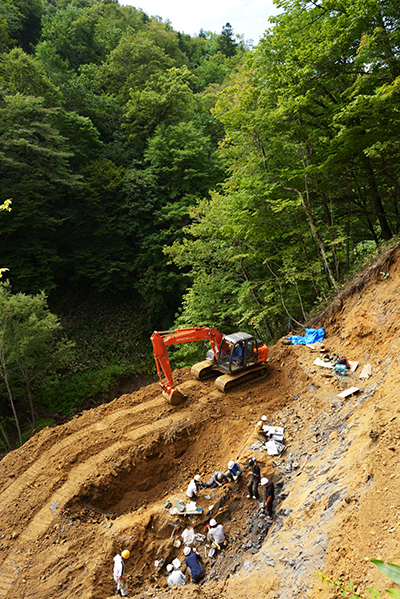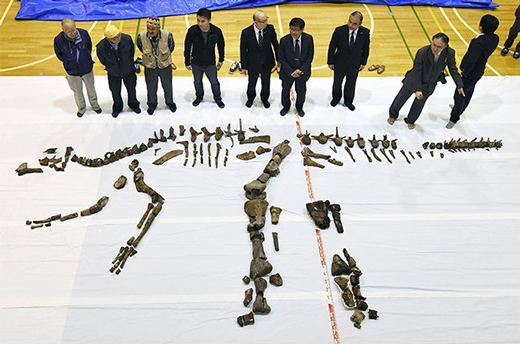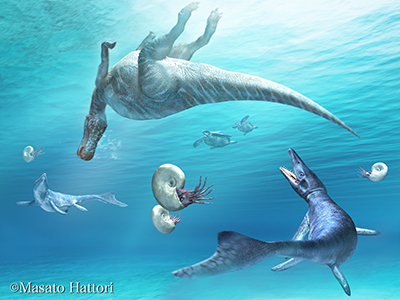Late Cretaceous Hadrosaur “Japan’s Greatest Dinosaur Fossil Find”
Scientists for Hokkaido University and Hobetsu Museum have announced the discovery of the fossilised remains of a Late Cretaceous duck-billed dinosaur. In truth, a number of fragmentary fossils relating to a dinosaur had been found some years earlier, most notably caudal vertebrae (tail bones), before a more detailed and larger scale excavation was carried out to determine just how much of the dinosaur skeleton laid buried on a steep slope forming part of the large hills on the island of Hokkaido.
A Duck-billed Dinosaur Skeleton
Many hundreds of hours of fieldwork later and some six tons of material have been removed containing one hundred and ninety fossils which represent the remains of an eight-metre-long hadrosaurid. The fossils of this duck-billed dinosaur are the largest and most complete dinosaur discovery from Japan. In a country where understatement tends to be the norm, some commentators have stated that the discovery of these fossils represent “one of the greatest discoveries in Japanese dinosaur research history.”
A Photograph Taken in 2013 Showing the Position of the Dig Site

The outcrop on the steep slope where the fossilised remains of the duck-billed dinosaur were found on Hokkaido (Japan).
Picture credit: Hobetsu Museum
Found in Marine Deposits
The hadrosaurid bones were found in the marine deposits of the Upper Cretaceous Hakobuchi Formation. These sediments represent continental shelf strata, with a water depth of anything from 80 to 200 metres. Scientists are not sure how the terrestrial dinosaur came to be located in offshore rock sediments. Perhaps the dinosaur was washed out to sea and drowned or, the carcase of a dinosaur could have travelled out to sea with the gases inside its large gut keeping it afloat before the body cavity was ruptured and the corpse sank and settled on the seabed. Ammonites and other zonal fossils indicate that the rocks from which the dinosaur was excavated are approximately 72 million years old (Late Campanian to Early Maastrichtian faunal stage).
A Photograph Showing the Dig Site with the Location of Several Bones Mapped Out
Picture credit: Hobetsu Museum
An Incredibly Rare Find
Japanese dinosaur discoveries are few and far between, with most of Japan’s dinosaurs having been described from a few, isolated fragments. Experts say it’s incredibly rare to unearth so many fossils and be able to piece back together almost the entire skeleton. Researchers from Hokkaido University and Hobetsu Museum are confident that these fossils will prove to be a new species of duck-billed dinosaur.
The excavation and preparation work has taken a total of four years. Fortunately, the researchers had been posting regular updates on their progress to keep the inhabitants of the nearby town of Mukawa (on the southern coast of Hokkaido), fully informed and to deter any curious parties attempting to remove any of the partially excavated remains.
Commenting on the significance of the discovery, Professor Yoshitsugu Kobayashi (Hokkaido University) stated:
“The fossils are also valuable in global terms. We hope to discover what kind of dinosaur habitat existed along the coast.”
The Cleaned Bones Laid Out in Anatomical Position (Japanese Hadrosaurid)
Picture credit: Avalon Red
For models of hadrosaurs and other dinosaurs: PNSO Age of Dinosaurs Figures.
The Hadrosaurid Fossils Probably Represent a New Species

The fossils of this duck-billed dinosaur represent the largest and most complete dinosaur discovery from Japan.
Picture credit: Avalon Red
The picture above shows the scale of the dinosaur and the number of fossil bones discovered, laid out in approximate anatomical position. The articulated section of caudal vertebrae, one of the first fossil finds at the site, are shown on the far right of the photograph.
An Artist’s Impression of the Hadrosaurid Corpse Floating Out to Sea
Picture credit: Masato Hattori
The “Mukawa Dragon”
The dinosaur has been nick-named the “Mukawa dragon” and it is hoped that an exhibit will soon be created telling the story of how this duck-billed dinosaur came to rest at the bottom of a shallow tropical sea and what its carcase can tell palaeontologists about life in the Late Cretaceous.
Other Japanese dinosaur discoveries:
Schoolboy finds dinosaur bone: Japanese Schoolboy Finds Dinosaur Toe Bone.
Hinting at a Japanese theropod: Fragmentary Fossil Teeth Indicate Large Japanese Theropod Dinosaur.









Leave A Comment